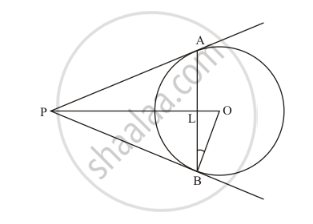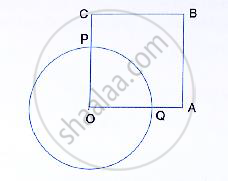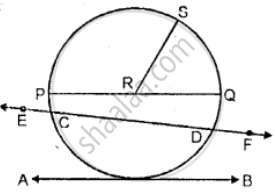Advertisements
Advertisements
Question
In the given figure, AB is a chord of length 16 cm of a circle of radius 10 cm. The tangents at A and B intersect at a point P. Find the length of PA.

Solution
Consider ΔPOB and ΔPOA.

From the property of tangents we know that the length of two tangents drawn form an external point will be equal. Therefore we have,
PA = PB
OB = OA (They are the radii of the same circle)
PO is the common side
Therefore, from SSS postulate of congruency, we have,
ΔPOB and ΔPOA
Hence,
ΔOPA = ΔOPB …… (1)
Now consider ΔPLA and ΔPLB. We have,
∠OPA = ∠OPB (From (1)
PA is the common side.
From the property of tangents we know that the length of two tangents drawn form an external point will be equal. Therefore we have,
PA = PB
From SAS postulate of congruent triangles, we have,
ΔPLA ≅ ΔPLB
Therefore,
LA = LB
It is given that AB = 16. That is,
LA + LB = 16
LA + LA = 16
2LA = 16
LA = 8
LB = 8
Also, ALB is a straight line. Therefore
∠ALB = 180°
That is,
∠PLA+∠PLB=180°
Since ΔPLA=ΔPLB
∠PLA=∠PLB
Therefore,
2∠PLB=180°
∠PLB=90°
Now let us consider ΔOLB. We have,
`OL^2=OB^2-OL^2`
`OL^2=10^2-8^2`
`OL^2=100-64`
`OL^2=36`
OL=6
Consider ΔOPB Here,
∠OBP=90° (Since the radius of the circle will always be perpendicular to the tangent
at the point of contact)
Therefore,
`PB^2=OP^2-OB^2` …… (1)
Now consider ΔPLB
`PB^2=PL^2+BL^2` …… (2)
Since the Left Hand Side of equation (1) is same as the Left Hand Side of equation
(2), we can equate the Right Hand Side of the two equations. Hence we have,
`OP^2-OB^2= PL^2+LB^2` …… (3)
From the figure we can see that,
OP = OL + LP
Therefore, let us replace OP with OL + LP in equation (3). We have,
`(OL+PL)^2-OB^2-PL^2+LB^2`
We have found that OL = 6 and LB = 8. Also it is given that OB = 10. Substituting all
these values in the above equation, we get,
`(6+PL)^2-10^2=PL^2+8^2`
`36+PL^2+2xx6xxPL-100=PL^2+64`
12PL=128
`PL=32/3`
Now, let us substitute the value of PL in equation (2). We get,
`PB^2=(32/3)^2+8^2`
`PB^2=(1024)/9+64`
`PB^2=(1600)/9`
`PB=sqrt((1600)/9)`
`PB=40/3`
We know that tangents drawn from an external point will always be equal. Therefore,
PB = PA
Hence, we have,
`PB=40/3`
APPEARS IN
RELATED QUESTIONS
From a point T outside a circle of centre O, tangents TP and TQ are drawn to the circle. Prove that OT is the right bisector of line segment PQ.
In fig. a circle touches all the four sides of quadrilateral ABCD with AB = 6cm, BC = 7cm, CD = 4cm. Find AD.
In the following figure, OABC is a square. A circle is drawn with O as centre which meets OC
at P and OA at Q. Prove that:
(i) ΔOPA ≅ ΔOQC, (ii) ΔBPC ≅ ΔBQA.

In the given figure, O is the centre of the circle. PA and PB are tangents. Show that AOBP is cyclic quadrilateral.

Find the length of the chord of a circle in the following when:
Radius is 13 cm and the distance from the centre is 12 cm
Use the figure given below to fill in the blank:
R is the _______ of the circle.

The diameter of the circle is 52 cm and the length of one of its chord is 20 cm. Find the distance of the chord from the centre
A chord is at a distance of 15 cm from the centre of the circle of radius 25 cm. The length of the chord is
A point P is 10 cm from the center of a circle. The length of the tangent drawn from P to the circle is 8 cm. The radius of the circle is equal to ______
Draw any circle and mark
- it's centre
- a radius
- a diameter
- a sector
- a segment
- a point in its interior
- a point in its exterior
- an arc
